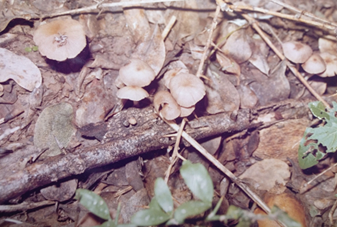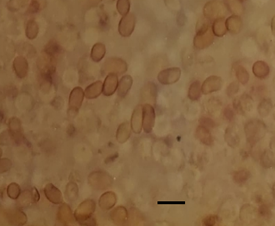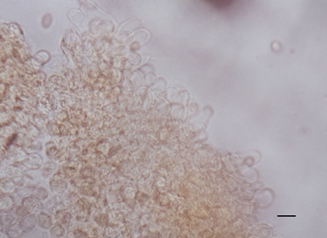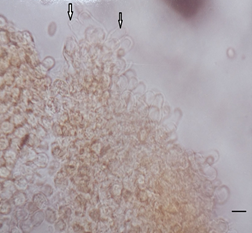Psathyrella pygmaea (Bull.) Singer, Lilloa 22: 467 (1951) Fig.8
MycoBank number: MB 282858; Index Fungorum number: IF 282858; Facesoffungi number: FoF 10773;
Basionym: Agaricus pygmaeus Bull., Herbier de la France 11: t. 525:2 (1791)
Synonyms: Drosophila pygmaea (Bull.) Quél., Enchiridion Fungorum in Europa media et praesertim in Gallia Vigentium: 117 (1886)
Naucoria pygmaea (Bull.) Gillet, Les Hyménomycètes ou Description de tous les Champignons qui Croissent en France: 544 (1876)
Psathyra pygmaea (Bull.) Quél., Comptes Rendus de l´Association Française pour l´Avancement des Sciences 9: 664 (1881)
Phaeomarasmius pygmaeus (Bull.) Singer, Lilloa 22: 577 (1951)
Pileus 0.6 – 1.7 cm in diameter, surface brown ,conical to campanulate, expanding, umbonate with a dark brown umbo, cap translucent with striate margin , flesh thin, smooth. Stipe length 1.0 – 3.0 cm × 0.1 – 0.5 cm in diameter, white, glabrous, cylindric with a sub-bulbous base, fistulose, veil absent. Lamellae pale pink to dark- brown, adnexo- adnate, broad, very crowded, edge white. Spores 5.5 – 7.0 × 3.3 – 4.0µm, ellipsoid, apically truncated by a germ pore, dark- brown, translucent, thick-walled and smooth. Basidia 4-spored, clavate in shape. Lamellae edge heteromorphous with numerous cheilocystidia which are metuloidal,ventricose to lageniform, with a short neck and an obtusely rounded apex, frequently crystalline encrusted.Pleurocystidia abundant, metuloidal, fusoid to lageniform with a thickened apex, hyaline to yellowish with an apical crystalline encrustation.
Ecology and distribution – Psathyrella pygmaea has been reported by Pegler (1977) from East Africa, growing on fallen trunk of trees . It has also been reported by ral Europe, Asia, Africa, South America (Guzmán 1970, Sulzbacher et al. 2013) and Brazil (Gurgel et al. 2008, Montagner et al. 2015), Mexico (Guzmán et al. 2013) and Argentina (Nouhra et al. 2012). Presently, it has been reported from Mount Abu, Sirohi district of Rajasthan and was found growing gregarious, on humus rich soil amongst leaf litter, widespread after rainfall .
Specimens Examined – JNV/Mycl/1031 by Reenu Chouhan, 24°53’18.17″N72°50’52.58″E Sirohi, elevation: 321 m (1,053 ft), Mount Abu72.7083°E 24.5925°N, Sunset Point, 24.5995° N 72.6978° E elevation: 1108m.
Note – The specimens described here is. Psathyrella pygmaea . A distinct Pleurocystidia up to 35 μm long, mostly with distinct crystals….P. pygmaea Yan & Bau (2018) from Northeast China.

a

b

c

d
Fig.8 a Fruiting bodies of Psathyrella pygmaea growing on humus rich soil on twigs and amongst leaf litter. b Spores. c. Hymenium layer with cheilocystidia and pleurocystidia Scale bar: b = 20 µm, c,d = 15 µm
